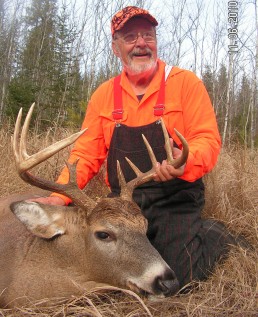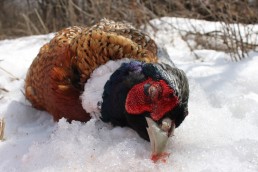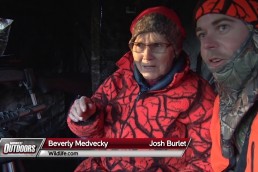A Twelve-Pointer
SHARE THIS POST
“Take a look at that antler rub,” I said, pointing ahead.
“No small buck made that one,” my son John replied.
“I haven’t noticed any measurable hoof prints on this deer trail so far, but that rub is appropriate for the buck that made those shiny, one-inch clumped droppings we spotted up the hill behind us.”
Shortly, the deer trail we were following eastward ended on a well-used north-south deer trail coursing through dense, 3- to 4-foot-tall yellow grasses on an old logging trail. From there, another large diameter rub about 50 yards south beckoned us in that direction. Not far beyond this rub, we came upon an unusually large, recently renewed ground scrape, about six feet long and three feet wide. Crossing this scrape was another well-used deer trail, emerging from a dense stand of 10-foot spruce trees on our left and coursing into tall timber, mostly aspens, on our right.
“I’ve got to check this cross trail,” I said to John. “While I’m doing this, you check the trail heading south toward that clear-cut.”
Thirty minutes later, John and I discussed our findings back near the big ground scrape. “This cross trail is loaded with fresh and old tracks four inches long and droppings one inch long, meaning the big buck that made this scrape has been using this trail often,” I told John. “What did you find?”
“About the same,” John replied. “That clear-cut is full of red osiers and will probably be a popular whitetail feeding area after deer begin feeding on browse during the second week in November.”
“There is something weird about all the deer signs we have discovered in this relatively small area. This buck is acting like a lesser buck that has been evicted from its home range by a dominant breeding buck before breeding begins, and this area appears to be its temporary hideaway until November breeding ends. This would be normal for a buck lower in the local buck pecking order during late October, but this buck is really big. It could even be a 300-pounder, a common weight for dominant breeding bucks in this region. It makes me wonder how big the dominant breeding buck of the surrounding square mile might be.
“Nonetheless, though this site is about a mile and a half from our deer camp, this buck is now my number-one choice of bucks to hunt this November—mostly because unlike dominant breeding bucks, this particular buck will not be moving to new sites daily while searching for and accompanying does in heat throughout our two-week hunt.
“Because a south wind has been very common on opening weekend during the past several years, that wide, six-foot spruce tree in the deep grass about 50 yards north of where we are standing looks like a perfect blind for hunting this buck. All it will take to prepare that site for ground level stand hunting is to stamp down grasses where I plan to sit on my backpacked stool behind that tree. Let’s get that done and then get out of here. Hopefully by the opener, this buck will have forgotten all the trail scents we have deposited at this site during the past hour.”
Two weeks later, at 4 a.m. when our deer camp alarm clock began ringing on opening morning, I sprang from my sleeping bag, got a fire going in our two-barrel wood stove, got coffee water heating on our propane cookstove and stepped outside to check the direction the smoke was pouring from the top of our smoke pipe. “The wind is light from the southeast—perfect for where I’m going,” I announced upon reentering our big tent, arousing groans from some of my hunting partners. Meanwhile, our deer camp weather radio forecast for the day included a strong wind warning beginning about 9 to 10 a.m.—sure to make the woods noisy enough to keep our whitetails bedded throughout the day.
Are you enjoying this post?
You can be among the first to get the latest info on where to go, what to use and how to use it!
I headed out at 5 a.m. to get to that stand site in deep grass by one hour before sunrise. Following the fluorescent tacks I had marked my trail with two weeks earlier, I made it to my cubbyhole in the deep grass without a single stop along the way. Figuring I probably wouldn’t see that buck at that trail junction until it finished feeding somewhere nearby, I sat down on my stool and prepared for a wait of up to about three hours. After pulling down my camo headnet and donning dark gloves, I eased my rifle through an opening between boughs of the spruce tree in front of me that would enable me to comfortably take aim at a buck at the junction of those two trails.
As the nine-o’clock hour approached, however, the wind had become strong enough to make the frozen, dried leaves on a nearby red oak begin rattling like castanets. This was worrisome. I then took another look at the junction of these two trails though my scope, with my rifle’s forearm resting on a branch next to the trunk of my spruce tree. At that precise moment, a big buck marched out of the dense stand of spruce trees on the left and halted on the enormous ground scrape to scan its surroundings. Upon noting it had more tines on its main beams than I had ever seen on a buck during a hunting season, I took aim at a portion of the buck’s neck where I was certain I’d hit spinal vertebrae—my long-favorite drop-‘em-in-their-tracks target on a deer. At the shot, the buck dropped as expected.
It should be noted here that, though I took this buck exactly as I imagined I would weeks earlier, which happens now and then, most of my hunts for mature bucks in my 77 years of hunting whitetails did not end as smoothly. In fact, I will freely admit I that have hauntingly goofed up more opportunities to take older bucks than I’ve actually taken, which I believe is the curse of being knowledgeable and skilled enough to often see big, unsuspecting bucks short distances away during hunting seasons. For quite a few reasons—including having already successfully avoided me during the previous four to six hunting seasons—quite a few older bucks I have known were simply not destined to be taken by a hunter using traditional deer hunting methods. By their seventh winter, however, all but one I have known finally became easy prey for wolfpacks.
So, that’s the kind of deer my family and I have been hunting almost exclusively since 1960: Mostly “wasted” (up until that point unharvested) mature bucks 3 1/2 to 6 1/2 years of age, only 10 percent of which actually became dominant breeding bucks. That means that most of the deer we’ve taken did nothing to maintain or improve deer populations. Those are good deer to hunt, like the trophy buck in the accompanying photo.
Dr. Ken Nordberg has been an avid hunter and angler for over 70 years and an outdoor writer for nearly 40. He has written 800+ outdoor articles, made three decades of contributions to MidWest Outdoors and written 15 outstanding books on deer and bear hunting. In addition, he’s a teacher, seminar speaker and blogger and you can find some of his work on YouTube and other social media.
MWO
SHARE THIS POST
Did you enjoy this post?
You can be among the first to get the latest info on where to go, what to use and how to use it!
Dr. Ken Nordberg
Based on his 55 years of field research, Dr. Ken Nordberg has written more than 800 magazine articles, 12 books on whitetails—including the famous Whitetail Hunter’s Almanac series—five books on black bear hunting and produced Buck and Bear Hunting School videos. You may peruse his encyclopedic website with whitetail hunting tips: drnordbergondeerhunting.com, his blog: drnordbergondeerhunting.wordpress.com, or social media pages.



